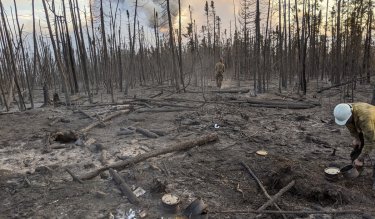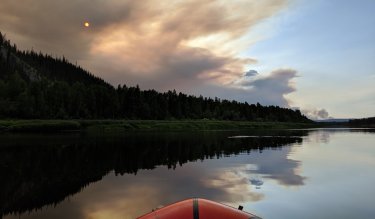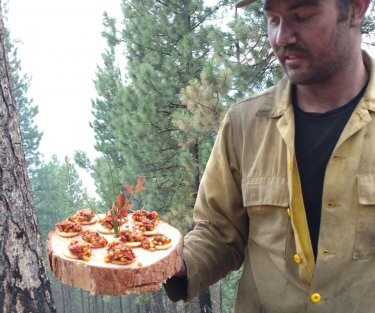He still remembers the first time he saw one of these elite squads in action. He was in Utah, working on a wildland engine company, driving to incidents in a small, off-road fire truck, when his crew was dispatched to a fire. A pillar of black smoke was visible for hundreds of miles. It was everything they had trained for, and Gavin was ready for action. Upon arrival, however, he was relegated to manning a water supply station while he watched the twenty thousand–acre blaze from the far side of a mountain.
The afternoon was dark and the sun was glowing red behind the haze. A brow of ash had collected on the brim of his helmet. Radios squawked and a parade of engines rumbled back to the fire line, water tanks topped off with a fresh five hundred gallons. But something caught Gavin’s attention: a distant, high-pitched hum was rising above the commotion. It grew to an earth-shaking roar as a small airplane tore through the smoke. He looked up as a team of firefighters leapt out and parachuted directly onto the front line, where an ominous orange glow hung over the mountain like a storm cloud.
“I’d never seen anything like it,” he says. “Those guys were the special forces.”
Once the jump plane fades into the distance, Gavin’s crew is utterly alone — backup may not arrive for days, if at all. Harder still, Alaska’s interior lacks an extensive road network, so they must be prepared to spend more than a week in the backcountry, cutting firebreaks in the permafrost, often for eighteen hours a day. Along with their firefighting tools, they must carry with them all the essentials for survival: shelter, water, medical supplies and food.
One staple of wilderness firefighting, according to Gavin and others, is SPAM® classic.
Since the first smokejumpers took to the sky in 1939 — the experiment that inspired the development of the 101st Airborne Division — SPAM® products have been an important part of the culture and cuisine of backcountry firefighters. The base in Redding, Calif. has a plaque commemorating the commercial introduction of the SPAM® brand just two years before that inaugural jump. Other crews maintain an annual tradition where everyone eats a can in remembrance of those daring pioneers. In the years since, the food has become so synonymous with the job that, during a 2019 fundraising auction in Missoula, one geneous buyer reportedly bid $380 on a case of SPAM® products to add to his collection of firefighting memorabilia.
The most physical part of the job begins once the smokejumpers’ boots are on the ground. Instead of dousing the flames with water, they use chainsaws and Pulaskis — an instrument that’s half axe and half hoe — to cut back unburned fuel and stop the fire’s spread. Chopping and shoveling, carrying upwards of a hundred pounds of gear, they move on foot along the fire’s edge, often covering more than twenty miles in a day. The interior of Alaska, where mountains loom overhead and icy streams weave through dense forests, makes for tough walking any time of year, and Gavin’s crew has gone to work in conditions ranging from early-season snow to blistering summer heat.
Under such unrelenting stress, a smokejumper’s body burns through calories like a coal furnace.
Water canteens become lifelines, and a hot meal before bed takes on an almost sacred importance. “Trudging through the soot, cutting line for miles, we don’t have a couch to look forward to at the end of the day,” Gavin explains. “Sometimes all you can think about is dinner.”
Due to the length of their assignments, the Alaska crew favors versatile foods that they can prepare in as many ways as possible. Getting sick of a repetitive meal is a genuine concern. If food fatigue strikes, it can turn eating into a chore, revoking that rare comfort that gets the smokejumpers through those long days on the side of a mountain, feeling the heat at their backs. SPAM® classic, Gavin says, lends itself well to creative, even unconventional, cooking.
“Sometimes if I’m tired, I’ll just dice it up inside the can, season it with a little Gatorade powder, and put it on the campfire coals,” he says. “But I’ve seen people get pretty elaborate.” A favorite meal among his crew is a backcountry crumble, where fried SPAM® classic is placed in a stewpot with oatmeal, canned peaches, dried berries, and condensed milk. After letting it simmer over the fire, the chef tops it with a crushed-cracker crust and voilà, it’s ready to be served on a chainsaw-cut wooden platter.
These moments around a campfire at the end of a long day are a vital part of what Gavin loves about being a smokejumper. “All of us are here for the challenge of it, the fact that none of us know what the next day will bring. But there’s also a sense of family here that I’ve never found in another job,” he says. “And jumping out of airplanes to fight fire, that part’s hard to beat.”



